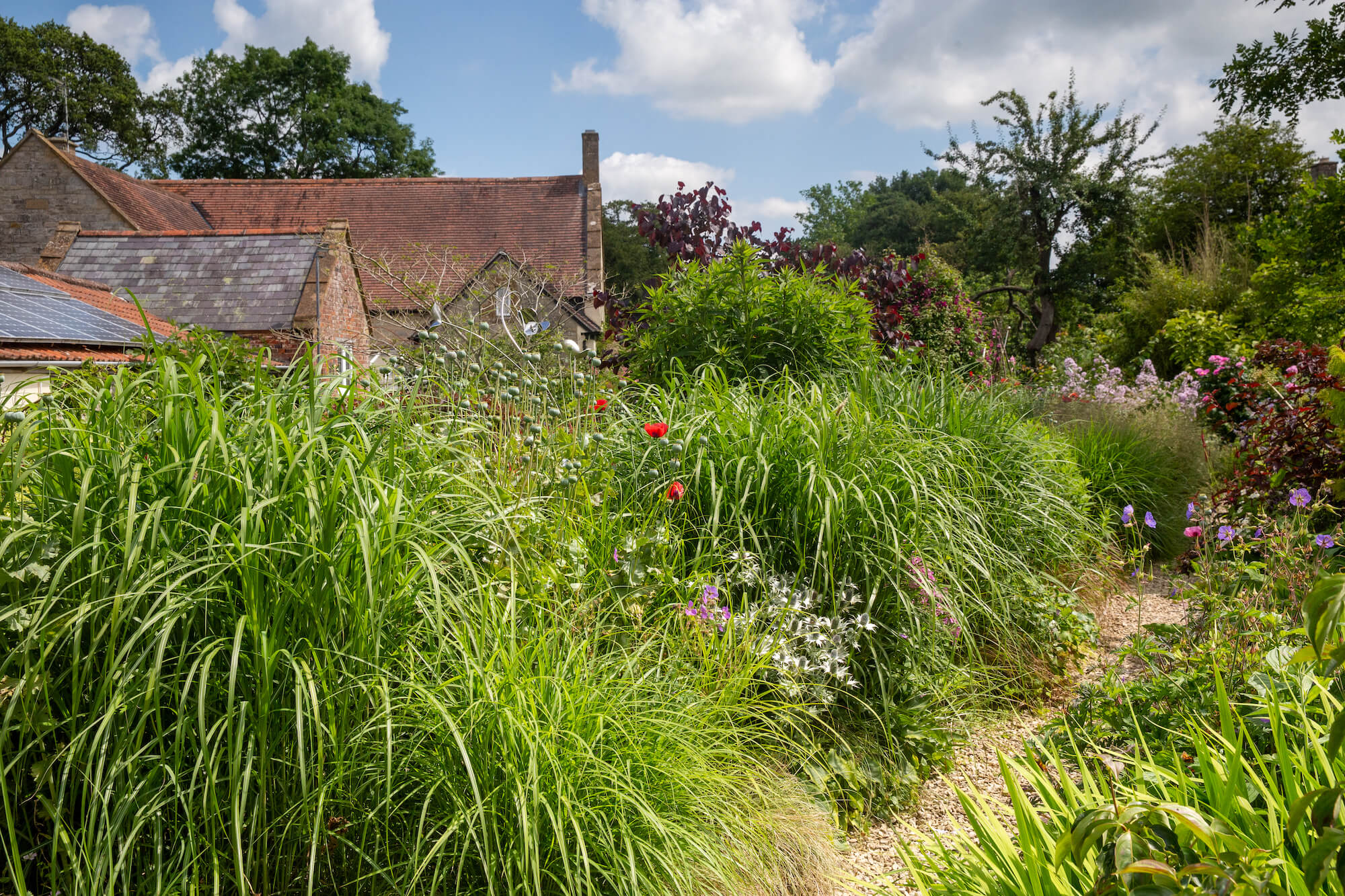Don’t try using the front door at Rugg Farm; plants are the doorkeepers here barring your access to the 200-year-old farmhouse and giving a clue as to what can be expected in this two acre garden. Plants, plants, and more plants! A 14-year project of friends Peter, Morene, Christine and Steve, Rugg Farm was open the day before our visit as part of the National Garden Scheme and due to its popularity another group was also booked in for the following day. The reason for your barred entry: the front garden is a wonderful mix of shrubs and herbaceous plants with Cotinus, Spirea, Red Bistort, fine leaved Hebe parviflora and the wonderful but rarely seen purple-leaf plantain (Plantago major ‘Rubrifolia’) all billowing onto the paths and elegantly blocking access to the front door.
A grass path takes you across the front of the farmhouse to the pond complete with a small wooden crossing all enveloped in a mass of planting with grasses, Lamium, an Acer, a Deutzia, and perennials all backed by an 8ft privet hedge giving privacy from the road. Nearby, a gravel seating area complete with a pair of Lutyens style benches is shaded by a mature cider apple tree that is one of the few plants that were put in the garden around a century ago. On this side of the house the garden opens out to a lawned area with some mature trees including a large plum clothed in the scented, mauve flowered, Clematis ‘Betty Corning’. There’s also an old cooking apple variety ‘Lord Grosvenor’ (sometimes known as ‘Lawry’s Number One’) introduced to cultivation around 1872 and planted here at the start of the 20th century.
At the end of the lawn a minimal stainless-steel archway by artist Andy Stevenson makes a subtle transition into a densely planted area with a network of gravel pathways intentionally designed to let the visitor explore and get lost amongst the shrubs and perennials. Other sculptures and pieces by Andy are located around the garden. The list of plants in this area is extensive but includes Verbena ‘Bampton’, dark leaved Angelica ‘Ebony’, Piptanthus, Veronica ‘Mammuth’, Cercis ‘Merlot’ and a favourite white flowered Persicaria picked up from a visit to international garden designer and plantsman Piet Oudolf.
A small seating area hidden in the planting is beautifully enhanced by a small feature where water runs gently down over a series of sculpted metal Ricinus leaves onto pebbles. Nearby a circular steel pergola is well planted with a selection of Clematis including ‘Aldanoosa’, ‘Polish Spirit’, ‘Blue Angel’, and 'Duchess of Albany’.
Walking out of a gate and past a barn takes you to the fenced vegetable garden. Comprising a number of wooden edged raised beds intersected by mypex paths, and centred around some tall, clipped bay trees, many of the crops are well protected from pests by the use of hoops and fine mesh. Vegetables grown include broad beans, courgettes, fennel, carrots, celeriac, and brassicas. To the side of the plot, raised planters on steel legs offer easily accessible salads sown in succession while in one of the raised beds tomatoes ‘Crimson Plum’, ‘Cocktail Crush’, and ‘Mountain Magic’ are grown.
There is a dedicated strawberry bed and a nearby fruit cage is planted with raspberries and gooseberries with a large productive bed of rhubarb outside. Another gate leads through to the orchard where a meadow containing many of Somerset's endemic species is managed traditionally to reduce fertility and maintain biodiversity. A small orchard has been created and planted with Apple varieties ‘St. Edmunds Pippin’, ‘Adam’s Pearmain’, ‘Blenheim Orange’, ‘Ashmeads Kernel’, and ‘Tidicombe Seedling’. Crab apples ‘Everest’, ‘Red Sentinel’, ‘Golden Hornet’, and Butterball’, are also included along with the Pear variety ‘Invincible’.
Other areas around the perimeter have been planted with silver birch, Cornus kousa, and two fine tulip trees, one of which is variegated.
Returning to the house we find the stable courtyard. The stables have lost their equine inhabitants and are now convenient areas for utility rooms and storage. The courtyard, now a beautiful place to sit, is surrounded by yet more expertly grown plants. Centrally located are a large number of pots planted with a wide range of dahlias while up against the walls are pots containing Plectranthus, silver leaved Senecio ‘Angel Wings’, Eucomis ‘Sparkling Burgundy’, Salvia discolor, and filigree leaved Albizia ‘Summer Chocolate’. Another paved seating area around the corner features an old disused well, planted with a range of succulents such as Echeverias and black leaved Aeonium ‘Zwartkopf’. Though shy flowering, the huge white blooms of a magnificent Magnolia grandiflora grown against the house are a stunning site.
Rugg Farm is a superb example of what can be done when a group of likeminded individuals come together with vision and enthusiasm. Hard work and planning are obviously required but the results of this combined passion are plain to see.
14 July 2021

















